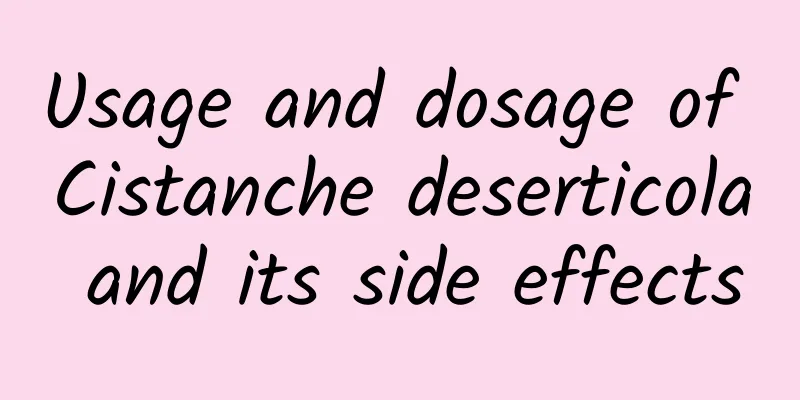Effects and functions of fried red peony root

|
Red peony root is a relatively common medicinal material. Stir-fried red peony root is red peony root that has been stir-fried, and its effects are the same as those of red peony root. Generally speaking, the main effects of fried red peony root are: clearing the liver and improving eyesight, clearing heat and cooling blood, inhibiting bacteria, dispersing blood stasis and relieving pain, increasing coronary blood flow, and anti-coagulation effects, etc. In traditional Chinese medicine, this medicinal material is used more frequently. Below, I will introduce you to the relevant knowledge about stir-fried red peony root in detail. 1. Efficacy and function of red peony root 1. Clear the liver and improve eyesight Red peony root is bitter and cold, enters the liver meridian and clears liver fire. It can be used to treat red, swollen and painful eyes, carbuncles, ulcers and other symptoms. 2. Clear away heat and cool blood Red peony root is bitter and cold and enters the blood of the liver meridian. It is good at clearing away liver fire, relieving stagnant heat in the blood, and achieving the effect of cooling blood and stopping bleeding. Therefore, red peony root is used for rashes caused by warm toxins, vomiting and epistaxis caused by blood heat. 3. Antibacterial Red peony root can inhibit the effects of many cocci, bacilli and certain pathogenic fungi. 4. Dissipate blood stasis and relieve pain Red peony root is bitter and cold and enters the blood of the liver meridian. It has the effect of promoting blood circulation, dispersing blood stasis and relieving pain. It can be used for liver depression, flank pain, amenorrhea, dysmenorrhea, abdominal pain due to masses, and injuries from falls. 5. Increase coronary blood flow Red peony root can dilate coronary arteries, increase coronary blood flow, improve myocardial ischemia induced by neurohypophysis and cardiac fibrillation caused by electric stimulation, reduce pulmonary artery pressure and portal hypertension, and improve blood circulation function. Therefore, red peony root also has the effect of anti-atherosclerosis. 6. Anticoagulant effect Red peony root decoction and ethyl gallate can significantly inhibit platelet aggregation in in vitro thrombosis, and can effectively resist platelet aggregation and thrombosis, thus playing an important role in improving microcirculation and reducing portal hypertension. 2. Red Peony Root Treatment 1. Treatment of bloody diarrhea and abdominal pain 50 grams each of red peony root, phellodendron amurense (peeled and roasted), and sanguisorba officinalis. Grind and sieve the above three ingredients, take 15g each time, boil with a cup of rice water until 70% done, remove the residue and take it warm at any time. (Peony Decoction from Shengji Zonglu) 2. Treat epistaxis Grind red peony root into powder and take 2 qian of it with water. ("Shilin Guangji") 3. Treatment of acute mastitis 50-100 grams of red peony root and 10 grams of raw licorice. Decoction in water. If there is fever, add Scutellaria baicalensis and use the root of Bletilla striata and a little salt to mash and apply to the affected area. (Selected Data on Investigation of Single-ingredient Prescriptions) 4. Treating women with continuous hemorrhage and leucorrhea Cyperus rotundus and red peony root. Take equal parts of the above ingredients, grind them into powder, add a pinch of salt and two cups of water, boil until only one cup remains, remove the residue and drink. (The "Taiping Shenghui Fang" is like a god powder) 3. Taboos of Red Peony Root 1. "Compendium of Materia Medica" says: "People with blood deficiency and coldness should avoid this product." 2. "Compendium of Materia Medica" states: "Red peony root breaks blood, so it is not suitable for all blood deficiency diseases, diarrhea, postpartum lochia, lower abdominal pain, and ulcers." 3. "Annotations to the Classic of Materia Medica" states: "Xu (also known as 'Lei') pills are used as the remedy. They are incompatible with dendrobium and mirabilite. They are afraid of xiaoshi, turtle shell and small thistle, and are antagonistic to Veratrum." |
<<: The efficacy and function of cypress branches
>>: The efficacy and function of the ground ring
Recommend
The efficacy and function of Laoqianggu leaves
There are so many medicinal herbs in the world, a...
[Smart Farmers] Extraordinary Decade | A report card on the modernization of agriculture and rural areas over the past decade
Editor's note: Since the 18th National Congre...
Shocking! A female student from Shanghai International Studies University was thrown a "foreign object"! Multiple platforms urgently removed the app... What on earth is this?
Expert of this article: Liu Zhijun, Pharmacy Depa...
What are the uses of Lingzhi?
Ganoderma lucidum is a traditional Chinese medici...
The efficacy and function of kudzu leaves
Kudzu leaves are something that many people are v...
Danshen Ligustrazine
Danshen Chuanxiongqin is generally made into a ph...
How can we make them have more monkeys? The keepers are really worried
Key Points ★ Due to hunting and habitat shrinkage...
Chinese patent medicine for laxative
We often eat some dry food at night. Now is the e...
It can fly for 9 consecutive days, and the round-trip migration distance is close to the length of the equator! Uncover the legendary story of the "legless bird"
Beijing has always been an important breeding gro...
What are the effects and functions of split wood
Not everyone has a scientific understanding of th...
Guess whose baby this is?
Image source: Pinterest Dumb Guess the insects by...
A seemingly romantic killer - thick "fog" ahead
Produced by: Science Popularization China Author:...
The efficacy and function of Matsutake wine
The main ingredient of Matsutake wine is Matsutak...
How did the "excrement" from billions of years ago become precious geological "shit" material?
I remember a joke: A asked B, "Do you have a...
The efficacy and function of Veratrum
As people's research on traditional Chinese m...









